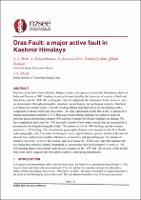| dc.description.abstract | Previous works have shown that the oblique tectonic convergence between the lithospheric plates of India and Eurasia in NW Himalaya is primarily manifested by the formation of a series of fold- and thrustbelts, and the ~NW–SE trending dextral strike-slip fault, the Karakoram Fault. However, here we demonstrate, through geomorphic, structural, seismological, and geological evidence, that there is evidence for another major ~NW-SE trending oblique fault that shows reverse faulting with a component of dextral strike-slip movement. The fault, named here as the Dras Fault, is identified in Jammu and Kashmir portions of NW Himalaya where oblique faulting was expected from the previous global positioning system (GPS) data but evidence for oblique faulting was lacking. We have mapped the fault zone for >540 km and it consists of two major strands that are separated by a prominently developed topographic ridge. The eastern portion is ~380 km long, and the western portion is ~ 165 km long. The characteristic geomorphic features were mapped on the 30 m shuttle radar topography, which includes the triangular facets, typical stream captures, displaced fluvial and alluvial fans, ruptured and displaced Holocene sedimentary and glacial deposits. The displaced markers vary from ~24 km to few meters, and the presence of ~33 km long ridge that separates the two major fault strands is hereby interpreted as a restraining fault bend structure. | |

